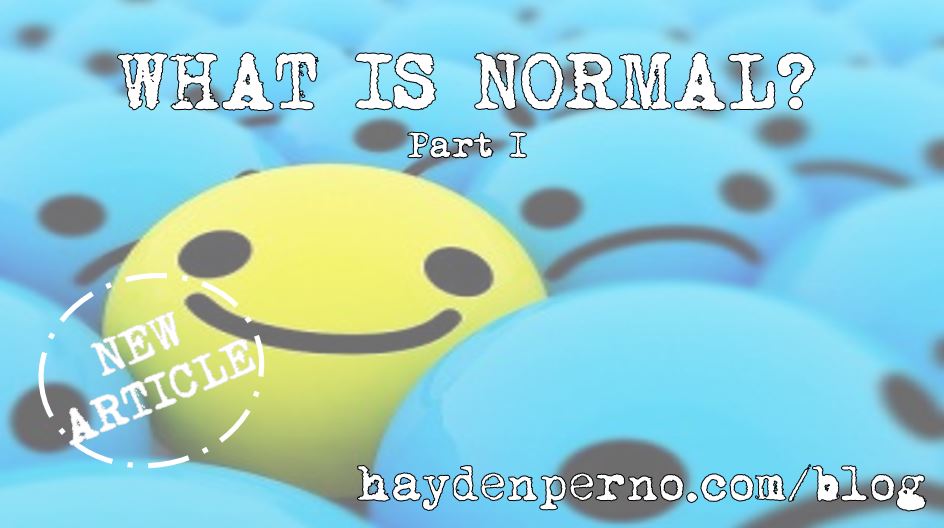The following is a handful of edited excerpts from an essay that I wrote this year for a philosophy subject. Due to the nature of philosophy, the questions/topics given to us were open-ended. We were quite free when deciding upon which one to choose, along with being able to shape it into how we would prefer the question to be. I ended up with the question: ‘What is the relationship between mental and bodily health?’. I’m thinking about posting a few excerpts from it over the next couple of weeks as I find that some of this content/discussion/information might be interesting to a lot of people. But, we’ll see what happens…
Once upon a time, acts such as hunting and beheading witches, invading land, inflicting mass genocide, and believing someone of homosexual orientation to be diseased, were seen to be normal. This term and concept of ‘normality’ is forever being influenced by society, culture, idealisms, expectations, and beliefs. To categorise normality, however, Christopher Boorse employs what he calls the biostatistical model. Within this model, he argues that to be considered normal, one must be both statistically average and biologically functioning.
Meeting the requisites for being statistically average requires one’s physiological and anatomical ranges (blood pressure, heart rate, height and weight) to exist within an “average zone”. Deviating outside of this “zone”, warrants the use of the term ‘abnormal’. To meet the biologically functioning criterion, one must possess the ability to survive and reproduce within their environment.
A model such as this is somewhat of a narrow approach. Let us consider the ‘abnormality’ (from the statistical perspective) infertility. While the reproduction component of Boorse’s model suffers here, a subjectivity surrounding this ‘abnormality’ arises. Jerome C. Wakefield argues this model by insisting that a subjective component must accompany the overall labeling of normality. In doing so, he displays that an alternate environmental upbringing can change the perspective for normality.
To elaborate, consider the following scenario between a high altitude mountaineer and a sea-level inhabitant. Whilst the mountaineer would exhibit a far superior ability to withstand consciousness in the low oxygen environment, the sea-level dweller would not. From a global statistical perspective, the mountaineer would indeed be considered to be ‘abnormal’. Yet when switching perspectives from a statistical to a subjective, we witness that the mountaineer would deem the sea-level individual as abnormal, and vice versa.
What is highlighted here is that is only a matter of environmental upbringing and setting that enables an alternate opinion towards the ‘normal’ and ‘abnormal’ labeling. What is also highlighted here is the tendency for one to prefer something and this then carrying over to what they deem as ‘normal’. To further these two points, let us return to infertility.
While statistics warrants the labeling of ‘abnormal’ upon medically diagnosed infertile individuals, bringing subjectivity to the table alters the entire story. For instance, consider the possibility for someone to prefer their infertility. A positive perception upon it would then open the door to a lack of worry regarding becoming pregnant, and it would also provide them with increased clarity of the mind to focus on other areas of life, such as career or travel. Furthermore, with an ever-growing population and the strain that it places on the Earth, there may come a time when society as a whole considers being infertile as ideal, and therefore normal.
In closing (again, this is a heavily edited excerpt. This is nowhere near the entire story. I will look to edit a few more sections of the paper and post it here over the next couple of weeks), there seems to be a stigmatization that surrounds ‘abnormal’. If we are to consider the result for a label such as this, we can see that this type of stigma can lead to social exclusion, social anxiety, distrust, worry, and even unwanted care. Furthermore, there can be repercussions due to this. On the one hand, depending upon the abnormality, it may lead to provoking the individual to dive deeper down their rabbit hole. On the other hand, it may lead to darker scenarios such as inflicting bodily harm upon themselves or others (this particular point will be addressed in the next excerpt from this paper where I discuss an inevitable biological error and its influence).
While there is no denying that there is a substantial ability for society, culture and environmental factors to influence what an individual believes to be ‘normal’ and ‘abnormal’, there must be a combination of subjectivity and statistics to provide a true definition of normal. To progress as a society, there must be a realisation for the power labeling can have and its ability to influence an individual’s direction in life.
If we are to again reminisce upon the beheading of witches or the labeling of a homosexual individual as diseased, we only need to trace these types of ‘normalities’ between 30 and 300 years ago. A recognition towards this provides an awareness that the very conditions that we deem as ‘normal’ now, may very well be considered to be ‘abnormal’ in the coming decades.


